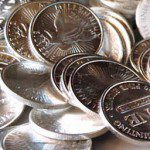…Pre-1965 silver coinage – dimes, quarters, and half-dollars – used to be called “pocket change” – everyone had some, saved some, spent some – [but it was much more than that because it was 90% silver]!
to be called “pocket change” – everyone had some, saved some, spent some – [but it was much more than that because it was 90% silver]!
- John F. Kennedy halves minted from 1965-70…[were only] 40% silver] and
- U.S. silver nickels [minted] from 1942-45 were only 35% silver…and
- U.S. silver dollars…[which, while also] 90% silver…[contain] 6.5% more silver than you’ll find in 10 dimes, 4 quarters, or 2 halves. Hefty silver dollars are in a class by themselves.
In 1965 Congress abandoned silver coin currency…as the nation was slipping into irreparable bankruptcy.
Here’s why you should own such coinage & how to calculate the value of such junk:
Why are “90%” silver coins called “junk” silver?
Another name for 90% silver is “junk silver.” That name came from coin dealers selling collectible rarities, decades before bullion was popular. To those dealers, 90% silver coinage was junk – valuable but unloved. Not so today, but the unflattering name stuck.
Why should you own 90% silver coins?
- The coins are perfect for small-purchase barter and making change. Their versatility in the bullion world is unmatched.
- Stocks of historic 90% coins are finite and supplies are dwindling. Billions of coins were melted for industrial purposes, and by private mints for their own brand-name bars and coins. Much of what’s left is simply off the market, vaulted away by “strong hands” who love their clunky bags and aren’t letting them go.
- The coins are legal tender – worth at least face value in a worst-case economic upheaval.
- If bags of coins seem bulky to stack, the coins can be rolled, which makes storage easier.
- Another safe bet – crooks aren’t counterfeiting pre-1965 pocket change.
As a modern endorsement, the demand for fractional coins and the growing shortage of 90% coins led the bullion industry to develop its own fractionals in tenth-ounce, quarter-ounce and half-ounce rounds.
How do you calculate the dollar values of 90% coins?
[Well, it’s] quick and easy, once you understand the mix…When news came that silver would disappear from coins by 1965, savvy stackers salted away silver coins, including newer dimes, quarters, and halves from the 1950’s and early 60’s. Their cost was an even trade of paper money for coins at face value – meaning no cost at all!…
Today’s bags of 90% coins are a mix of the older, worn coins, and newer, less-circulated coins. Marketing 90% coins by face value makes more sense than weighing each individual coin every time it’s bought and sold. The bullion market took wear and tear into account, determining a silver weight of .715 ounces per dollar as the go-to multiplier.
Your easy calculations:
- Multiply your coins’ face value by the spot price (melt value) of silver, then by .715.
- Example: $12.60 face x $15.85 spot x .715 = $142.79. It’s that simple.
- Add seller’s premiums (which market demand has currently pushed up into the 20-25% range) and you’re good to go.
- The formula to find ounces: Face value (12.60) x .715 = 9.009 silver ounces in $12.60 face value…
Disclosure: The original article, written by Guy Christpher (MoneyMetals.com), was edited ([ ]) and abridged (…) by the editorial team at  munKNEE.com (Your Key to Making Money!)
munKNEE.com (Your Key to Making Money!)  to provide you with a fast and easy read.
to provide you with a fast and easy read.
“Follow the munKNEE” on Facebook, on Twitter or via our FREE bi-weekly Market Intelligence Report newsletter (see sample here , sign up in top right hand corner)
Links to More Sites With Great Financial Commentary & Analyses:
ChartRamblings; WolfStreet; MishTalk; SgtReport; FinancialArticleSummariesToday; FollowTheMunKNEE; ZeroHedge; Alt-Market; BulletsBeansAndBullion; LawrieOnGold; PermaBearDoomster; ZenTrader; EconMatters; CreditWriteDowns;
Related Articles from the munKNEE Vault:
1. Check Your Change! Certain Recent US Coins Are Worth $Thousands
There are a number of U.S. error coins and die varieties in circulation today worth from $30 to $35,ooo because they have small distinguishing characteristics that make them rare and valuable. This article will tell you which of your pocket change coins might be worth a large premium over face value, and why. Words: 1100
2. Gold & Silver Use Unique “Troy” & “Karat” Measurements – What Do They Mean?
You have no doubt read countless articles on the price of gold costing x dollars per “troy ounce” or perhaps just x dollars per “ounce” but the difference between the two measurements is significant. For that matter, what’s the difference between a 24 karat gold ring and an 18 karat gold ring? Let me explain. Words: 963
 munKNEE.com Your Key to Making Money
munKNEE.com Your Key to Making Money
